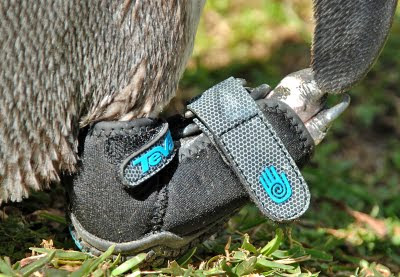The young Humboldt penguin named Lucky was born with a leg that was not growing properly, causing sores to develop where pressure was put on the wrong parts of his foot. These sores could have turned into a life-threatening condition if a solution was not found.
X-rays showed that Lucky's bones were not broken and while penguins normally walk on their toes, the condition caused him to walk on an unpadded area of his foot. Zoo veterinarians wrapped his foot and padded the ankle area to compensate but it meant that Lucky could not swim as the wrapping would become very wet and heavy.
So the idea for a protective shoe was hatched when Santa Barbara Zoo CEO, Rich Block, recalled that Teva® had developed a special shoe for an elephant with foot issues at San Antonio Zoo. With Teva's headquarters only a few miles away it was worth enquiring to see if they could make a little penguin shoe suitable for Lucky.
With Teva's historic background in developing footwear for water adventures they instantly took on the challenge. Due to the language barrier, several versions were required but Lucky made it easy for Teva® as what worked and what did not. With each new version the boot was adapted until Lucky was happy with the finished product, and here is the result:
 |
| The Teva® penguin shoe |
 |
| Teva's penguin shoe as worn by Lucky |
 |
| Lucky modeling his new shoe |
Furthermore, in the fall this year, UK children's book author and illustrator, Sarah Aspinall, is writing all about Lucky in a book with the proceeds from sales being used to support Lucky and the other Humboldt penguins at Santa Barbara zoo.
 |
| Sneak peak of the cover |
---------------------------------------------------------------------------------------------------






